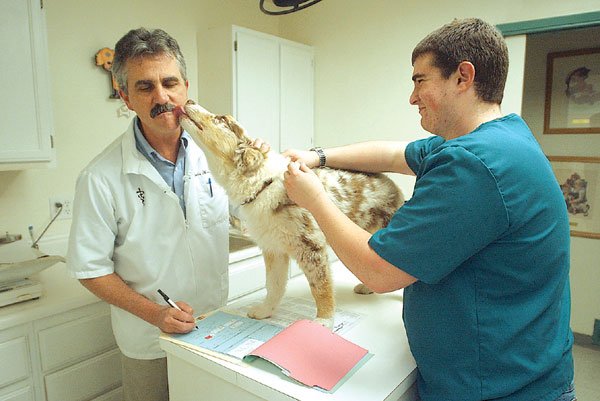The colorful bottles contain an array of essential vitamins and
minerals: vitamins A, B12, D and E; iron; calcium; copper; zinc;
niacin; biotin; even glucosamine. Dietary supplements are almost
essential for health-conscious Americans, but these bottles are not
for humans. They’re for pets.
The colorful bottles contain an array of essential vitamins and minerals: vitamins A, B12, D and E; iron; calcium; copper; zinc; niacin; biotin; even glucosamine. Dietary supplements are almost essential for health-conscious Americans, but these bottles are not for humans. They’re for pets.
Maintaining a healthy and well-balanced diet for Fido or Fifi is one of the core responsibilities of pet owners, and these days, supplements are becoming a more popular way to do that.
Supplementing a pet’s diet is not always necessary if the cat, dog or guinea pig is eating an appropriate, high-quality commercial food, veterinarians say.
“We don’t really prescribe a lot or recommend a lot of vitamins for pets at this clinic,” said Dr. Dennis Harrigan, a well-known Gilroy veterinarian with Gilroy Veterinary Hospital.
That’s because if pets are eating what they should – namely, pet food – they will usually get all the nutrients they need.
“If they’re on one of the high-quality diets, they really are complete, and we use different formulations for different times in their life,” said Dr. Kurt Moran, who has been practicing veterinary medicine at Animal Hospital of Hollister for three years. “An older dog has very different needs from young or even middle-aged dogs.”
Younger pets should eat food for young animals, which is usually higher in protein to fuel growth, while older pets need food that has less protein, fewer calories and less fat.
“Most of the pet food companies try really hard to make pet food that is as complete as they possibly can, and there’s been many modifications in pet foods over the years,” said Dr. Suzanne Colbert, a veterinarian at Westwood Animal Hospital in Gilroy for nearly eight years.
For example, many cats’ diets used to be deficient in taurine, an essential amino acid that helps feline hearts, reproduction and vision. Most other mammals are able to manufacture taurine themselves. Since it was discovered that cats need more taurine in their diet, it is included in adequate amounts in just about every cat food.
Now, veterinarians rarely see cats with health problems related to taurine deficiency, Colbert said.
But with dozens of brands and varieties of pet food available, especially for cats and dogs, which is best?
Of the three major types of food – generic, commercial and super-premium – one really does get what one pays for, said Dr. Shanna Compton, with Animal Care Center in Morgan Hill.
While a generic brand is formulated to include essential nutrients, “it does not necessarily measure how well these nutrients are absorbed, so animals on a generic diet essentially can cause malnutrition,” Compton said.
With generic and commercial foods (Alpo, Friskies, Purina), the amount of nutrients and ingredients listed on the label can vary up to 25 percent, according to federal law. So even if “beef” is listed as the first ingredient, it could be the third or fourth ingredient in terms of quantity.
Animals absorb less of lower-quality foods, so they need to eat more, and their owner is stuck with the pooper scooper.
Sometimes, pet owners who switch from a generic brand to a premium brand notice that Spot is eating less.
“My answer is, ‘I eat a lot more Dorritos than I do broccoli, but I also know what is healthier for me’,” Compton said.
Super-premium diets, on the other hand (e.g.: Science Diet/Hills, Purina Pro Plan, Iams, Eukanuba), are much more digestible, and their ingredients vary “maybe 2 percent,” she said.
“Since you’re getting a lot better absorption in the super-premium diet, you don’t need to eat as much so you get a lot more bang for your buck,” Compton said.
A wide variety of vitamins, minerals and supplements for everything from general health to specific problems, like dander control, are available at pet stores in pill, liquid, tablet and powder form.
Although daily multivitamins are usually unnecessary, they are specifically recommended for some pets.
“Sometimes, we do recommend that for older animals, but most of the pet foods nowadays are so darn well-balanced,” Harrigan said. “As we get older, unfortunately, we’re not absorbing our vitamins as well as we were at a younger age.”
Certain kinds of pets, particularly birds and reptiles, do require specific supplements, Harrigan said.
Birds need more than seeds, he said. They need vitamins sprinkled in their food or water. Reptiles need calcium supplementation.
Veterinarians advise checking with them before deciding to give vitamins and supplements to pets. Most pet owners seem to heed that advice, as local vets and pet store employees said people usually buy supplements based on a doctor’s recommendation.
“We don’t have a lot of people that are coming through that are supplementing their dog’s food with a lot of products,” Harrigan said. “Sometimes, they’re dosing (animals) like they would for humans, which is inappropriate.”
“You can definitely over-supplement, and puppies (are) a good example of that,” Colbert said. “If you feed a good quality diet and then supplement with calcium and phosphorous, you can cause the same bone abnormalities we’re trying to prevent.”
Certain supplements for skin and joint health that produce measurable results are catching on with both vets and pet-owners.
For dogs’ skin and coat health, fatty acids like Omega-3 (which people are supposed to consume for heart health) and Omega-6 can be found in both pill and powder form at most local pet supply stores.
“We do see a benefit to the coat on many dogs, and the problem is that it takes sometimes three or four months to see results,” Harrigan said. “But it’s not a bad thing, and it’s very easy to do by adding it to their diet.”
A cat’s method of grooming can sometimes result in hairballs, but there are supplements and even special foods available to combat the problem. Hairballs are the result of ingested hair mixing with mucus, and hairball remedies recommended by a veterinarian can help aid digestion and keep them from forming.
Pet owners and veterinarians are also favoring glucosamine and chondroitin, taken for joint health.
“Most vets fall in the same category as most (medical doctors), where we tend to kind of not supplement … in a huge way, mainly because there hasn’t been good scientific studies showing that those things work,” Moran said.
However, there are studies proving the effectiveness of glucosamine and chondroitin, he said. Several local pet stores said the products – also hugely popular among people – are easily the highest-selling pet supplement right now.
One interesting effect of the supplement craze is that pet food manufacturers are now adding amino acids, omega fatty acids and even glucosamine to their brands.
“These are things that people are looking for in diets,” Compton said. “They’re trying to make their animals, especially older pets, live longer, healthier lives.”
Pet owners are also improving their animals’ quality of life by keeping an eye on the scale. Television commercials advertise a weight-control cat food that promises to return the needle on the scale to where it belongs. Veterinarians usually weigh animals whenever they come in for a check-up and will let the owner know if there is a problem.
“Most of the time, if there’s a weight problem, if it’s not a metabolism problem or a thyroid problem, they’re not using the right type of food,” Moran said.
In those cases, vets recommend a more appropriate food, which usually solves the problem.
“Just like people, there are going to be some animals who metabolically seem normal … yet they’re overweight,” Moran said. “And I’ve had people swear they’re not feeding more than one or two times a day and, certainly, weight control animal food may help.”
Moran said that obesity in pets, as in humans, is becoming a significant problem. Too little exercise or too many pet or human treats are usually the culprits.
“I would say, here, I see a pretty significant amount of overweight animals, but usually it’s just a case of people (who should be) exercising their animal more or paying attention to how much they’re feeding,” he said.













